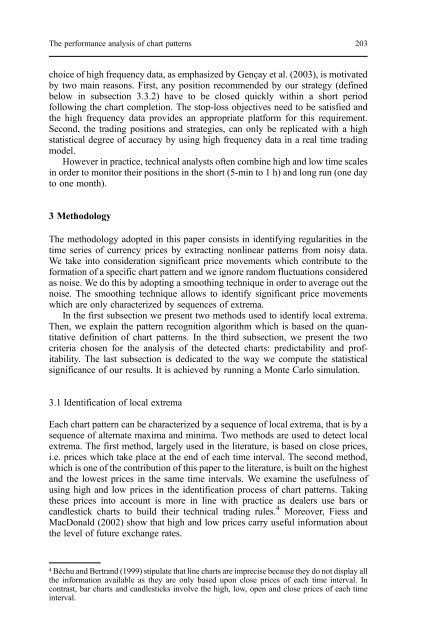recent developments in high frequency financial ... - Index of
recent developments in high frequency financial ... - Index of
recent developments in high frequency financial ... - Index of
You also want an ePaper? Increase the reach of your titles
YUMPU automatically turns print PDFs into web optimized ePapers that Google loves.
The performance analysis <strong>of</strong> chart patterns 203<br />
choice <strong>of</strong> <strong>high</strong> <strong>frequency</strong> data, as emphasized by Gençay et al. (2003), is motivated<br />
by two ma<strong>in</strong> reasons. First, any position recommended by our strategy (def<strong>in</strong>ed<br />
below <strong>in</strong> subsection 3.3.2) have to be closed quickly with<strong>in</strong> a short period<br />
follow<strong>in</strong>g the chart completion. The stop-loss objectives need to be satisfied and<br />
the <strong>high</strong> <strong>frequency</strong> data provides an appropriate platform for this requirement.<br />
Second, the trad<strong>in</strong>g positions and strategies, can only be replicated with a <strong>high</strong><br />
statistical degree <strong>of</strong> accuracy by us<strong>in</strong>g <strong>high</strong> <strong>frequency</strong> data <strong>in</strong> a real time trad<strong>in</strong>g<br />
model.<br />
However <strong>in</strong> practice, technical analysts <strong>of</strong>ten comb<strong>in</strong>e <strong>high</strong> and low time scales<br />
<strong>in</strong> order to monitor their positions <strong>in</strong> the short (5-m<strong>in</strong> to 1 h) and long run (one day<br />
to one month).<br />
3 Methodology<br />
The methodology adopted <strong>in</strong> this paper consists <strong>in</strong> identify<strong>in</strong>g regularities <strong>in</strong> the<br />
time series <strong>of</strong> currency prices by extract<strong>in</strong>g nonl<strong>in</strong>ear patterns from noisy data.<br />
We take <strong>in</strong>to consideration significant price movements which contribute to the<br />
formation <strong>of</strong> a specific chart pattern and we ignore random fluctuations considered<br />
as noise. We do this by adopt<strong>in</strong>g a smooth<strong>in</strong>g technique <strong>in</strong> order to average out the<br />
noise. The smooth<strong>in</strong>g technique allows to identify significant price movements<br />
which are only characterized by sequences <strong>of</strong> extrema.<br />
In the first subsection we present two methods used to identify local extrema.<br />
Then, we expla<strong>in</strong> the pattern recognition algorithm which is based on the quantitative<br />
def<strong>in</strong>ition <strong>of</strong> chart patterns. In the third subsection, we present the two<br />
criteria chosen for the analysis <strong>of</strong> the detected charts: predictability and pr<strong>of</strong>itability.<br />
The last subsection is dedicated to the way we compute the statistical<br />
significance <strong>of</strong> our results. It is achieved by runn<strong>in</strong>g a Monte Carlo simulation.<br />
3.1 Identification <strong>of</strong> local extrema<br />
Each chart pattern can be characterized by a sequence <strong>of</strong> local extrema, that is by a<br />
sequence <strong>of</strong> alternate maxima and m<strong>in</strong>ima. Two methods are used to detect local<br />
extrema. The first method, largely used <strong>in</strong> the literature, is based on close prices,<br />
i.e. prices which take place at the end <strong>of</strong> each time <strong>in</strong>terval. The second method,<br />
which is one <strong>of</strong> the contribution <strong>of</strong> this paper to the literature, is built on the <strong>high</strong>est<br />
and the lowest prices <strong>in</strong> the same time <strong>in</strong>tervals. We exam<strong>in</strong>e the usefulness <strong>of</strong><br />
us<strong>in</strong>g <strong>high</strong> and low prices <strong>in</strong> the identification process <strong>of</strong> chart patterns. Tak<strong>in</strong>g<br />
these prices <strong>in</strong>to account is more <strong>in</strong> l<strong>in</strong>e with practice as dealers use bars or<br />
candlestick charts to build their technical trad<strong>in</strong>g rules. 4 Moreover, Fiess and<br />
MacDonald (2002) show that <strong>high</strong> and low prices carry useful <strong>in</strong>formation about<br />
the level <strong>of</strong> future exchange rates.<br />
4 Béchu and Bertrand (1999) stipulate that l<strong>in</strong>e charts are imprecise because they do not display all<br />
the <strong>in</strong>formation available as they are only based upon close prices <strong>of</strong> each time <strong>in</strong>terval. In<br />
contrast, bar charts and candlesticks <strong>in</strong>volve the <strong>high</strong>, low, open and close prices <strong>of</strong> each time<br />
<strong>in</strong>terval.










